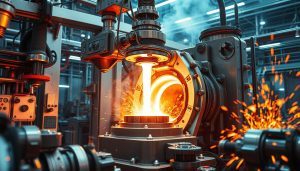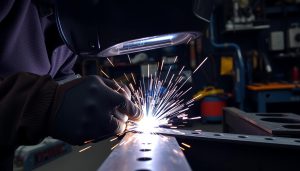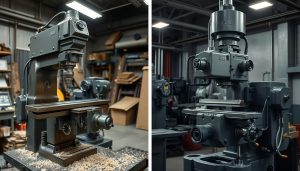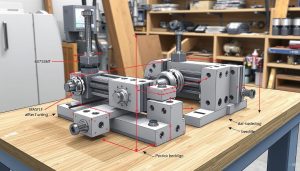As a metalworking enthusiast or professional, the choice between MIG (Metal Inert Gas) and TIG (Tungsten Inert Gas) welding can significantly impact the success and quality of your projects. These two welding techniques offer distinct advantages and are suitable for different types of materials, applications, and skill levels. In this comprehensive guide, we’ll delve into the world of MIG and TIG welding, highlighting their key differences, and help you determine which method best aligns with your specific needs.
Overview of MIG and TIG Welding
When it comes to welding techniques, two of the most widely used methods are MIG (Metal Inert Gas) welding and TIG (Tungsten Inert Gas) welding. Both processes have their unique advantages and are suitable for different types of projects. Let’s dive into the details of these MIG welding process and TIG welding process.
What is MIG Welding?
MIG welding is a semi-automatic process that uses a continuous wire electrode fed through a welding gun. The wire is fed into the weld pool, where it melts and fuses with the base metal. This process is known for its speed, ease of use, and ability to handle a wide range of materials, making it a popular choice for various industrial and DIY applications.
What is TIG Welding?
TIG welding, on the other hand, is a manual process that uses a non-consumable tungsten electrode to create the weld. The welder controls the flow of inert gas, such as argon or helium, to shield the weld pool and the electrode from atmospheric contamination. TIG welding is known for its precision, control, and ability to produce high-quality, aesthetically pleasing welds, especially on thin or delicate materials.
Key Differences Between MIG and TIG Welding
The main differences between MIG welding process and TIG welding process lie in the equipment used, the complexity of the process, and the types of materials they are best suited for. MIG welding is generally faster and easier to learn, making it a more suitable option for beginners and larger-scale projects. TIG welding, on the other hand, requires more skill and control but is better suited for thinner materials, precision work, and high-quality aesthetic finishes.
| Characteristic | MIG Welding | TIG Welding |
|---|---|---|
| Process | Semi-automatic with a continuous wire electrode | Manual with a non-consumable tungsten electrode |
| Welding Speed | Faster | Slower |
| Weld Quality | Good for general-purpose welding | Superior for precision and aesthetics |
| Materials | Wide range, including steel, stainless steel, and aluminum | Suitable for thinner materials, including stainless steel and aluminum |
| Skill Level | Easier for beginners | Requires more skill and practice |
By understanding the key differences between welding techniques comparison, you can make an informed decision on which method is best suited for your specific welding project.
Advantages and Disadvantages of MIG Welding
MIG welding, or Metal Inert Gas welding, is a popular choice among fabricators and DIY enthusiasts alike. This versatile technique offers a range of benefits, as well as some potential drawbacks. Let’s explore the key advantages and disadvantages of MIG welding.
Faster Process and Ease of Use
One of the primary advantages of MIG welding is its speed and ease of use. The continuous wire feed and automated process allow for quick and efficient welding, making it an ideal choice for high-volume projects or those with tight deadlines. Additionally, MIG welding is relatively straightforward to learn, making it accessible for both experienced welders and beginners.
Best Materials for MIG Welding
- Mild steel: MIG welding is particularly well-suited for joining mild steel, providing strong and durable welds.
- Stainless steel: MIG welding can be used to weld stainless steel, though the process may require additional shielding gas or filler material.
- Aluminum: MIG welding can also be used to join aluminum, though the process requires specialized equipment and techniques to achieve high-quality results.
Applications of MIG Welding
MIG welding finds widespread use across various industries, including automotive, construction, manufacturing, and even DIY projects. Its versatility makes it a popular choice for tasks such as fabricating steel structures, repairing farm equipment, and creating custom metal furniture or art.
While MIG welding offers numerous benefits, it’s important to consider the potential drawbacks as well. One of the main disadvantages is the limited control over the weld pool, which can result in less precise welds compared to TIG welding. Additionally, MIG welding may not be the best choice for welding thin materials or working in tight spaces due to the larger weld bead size.

Overall, MIG welding is a highly efficient and practical welding technique that excels in a wide range of applications. By understanding its advantages and limitations, you can make an informed decision on whether MIG welding is the right choice for your next project.
Advantages and Disadvantages of TIG Welding
Tungsten Inert Gas (TIG) welding is renowned for its exceptional precision and control, making it a popular choice in various industries. This versatile technique offers a range of benefits and drawbacks that are worth exploring.
High Precision and Control
One of the primary advantages of TIG welding is its ability to deliver high-quality, precise welds. The manual nature of the process allows for exceptional control over the weld pool, enabling welders to create intricate, aesthetically pleasing seams. This precision is particularly valued in industries where appearance and structural integrity are paramount, such as aerospace and medical equipment manufacturing.
Suitable Materials for TIG Welding
TIG welding excels at joining a wide range of materials, including stainless steel, aluminum, and titanium. These materials are often used in applications where corrosion resistance, strength, and lightweight properties are crucial, such as in the fabrication of motorcycles, bicycles, and high-end furniture.
Applications of TIG Welding
- Automotive and motorcycle repair and fabrication
- Aerospace and aircraft manufacturing
- Medical equipment and implant production
- Architectural and ornamental metalwork
- Pipe and tube welding for industrial applications
While TIG welding offers numerous benefits, it also has some drawbacks. The process is generally slower and more complex than other welding techniques, such as MIG welding, making it less suitable for high-volume production environments. Additionally, the learning curve for TIG welding is steeper, requiring more skill and training from the welder to achieve consistently high-quality results.
| TIG Welding Benefits | TIG Welding Drawbacks |
|---|---|
| High precision and control | Slower process compared to MIG welding |
| Suitable for a wide range of materials, including stainless steel, aluminum, and titanium | Steeper learning curve, requiring more skill and training from the welder |
| Produces high-quality, aesthetically pleasing welds | Less suitable for high-volume production environments |
TIG welding’s unparalleled precision and versatility make it the preferred choice in industries where quality, appearance, and material compatibility are of the utmost importance. While it may not be the fastest or most beginner-friendly welding technique, the benefits of TIG welding often outweigh the drawbacks for specialized applications.

When to Use MIG vs TIG Welding
Choosing between MIG and TIG welding can be a critical decision for any project, as the selection can significantly impact the quality, speed, and cost-effectiveness of the final outcome. By understanding the key factors that differentiate these two welding techniques, you can make an informed choice that best suits your specific needs.
Deciding Factors: Speed, Precision, and Material Type
The primary factors to consider when selecting between MIG and TIG welding are the required speed, level of precision, and the type of material being joined. MIG welding is generally faster and easier to learn, making it a popular choice for larger-scale projects or those with less stringent requirements. On the other hand, TIG welding offers superior control and precision, making it ideal for delicate or intricate work, as well as for welding thinner or harder-to-weld materials like stainless steel or aluminum.
Cost-Effectiveness: MIG vs TIG
| Criteria | MIG Welding | TIG Welding |
|---|---|---|
| Equipment Cost | Lower | Higher |
| Consumable Costs | Lower | Higher |
| Labor Costs | Lower | Higher |
| Overall Cost-Effectiveness | Generally more cost-effective for larger projects | May be more cost-effective for smaller, precision-focused projects |
In terms of cost-effectiveness, MIG welding typically offers a more budget-friendly option, especially for larger-scale projects. The equipment and consumable costs are generally lower, and the faster welding speed can translate to reduced labor costs. However, for smaller, precision-focused projects, the higher upfront investment in TIG welding equipment may be offset by the improved quality and control it provides.
Ultimately, the decision to use MIG or TIG welding should be based on a careful assessment of your project’s specific requirements, budget, and desired outcomes. By weighing the advantages and drawbacks of each technique, you can make an informed choice that ensures the best possible results for your welding needs.
TIG vs MIG Welding in Different Industries
When it comes to industry-specific welding techniques, the choice between MIG and TIG welding can make a significant impact on the final product. Each welding method has its own advantages and preferred applications, and understanding these nuances is crucial for businesses in various sectors.
Automotive Industry: MIG vs TIG
In the automotive industry, MIG welding is often the preferred choice due to its speed and efficiency. The fast-paced nature of automotive manufacturing requires a welding process that can keep up with the demands of high-volume production. MIG welding’s ability to provide strong, consistent welds makes it a go-to solution for automotive bodywork, frame components, and other structural elements.
Aerospace and Medical: Why TIG is Preferred
In contrast, the aerospace and medical industries often favor TIG welding for its precision and control. These sectors require exceptional quality and cleanliness, which TIG welding can provide. The controlled heat input and the ability to weld thin materials make TIG welding the ideal technique for manufacturing aircraft parts, medical implants, and other critical components where quality and appearance are paramount.
General Manufacturing and DIY: Why MIG Wins
For general manufacturing and DIY projects, MIG welding often takes the lead. Its ease of use and versatility make it a popular choice for a wide range of applications, from metal fabrication to home repairs. The ability to weld thicker materials and the reduced need for post-weld cleaning make MIG welding an attractive option for businesses and hobbyists alike.
| Industry | Preferred Welding Technique | Key Considerations |
|---|---|---|
| Automotive | MIG Welding | Speed, consistency, and strength for high-volume production |
| Aerospace and Medical | TIG Welding | Precision, control, and cleanliness for critical components |
| General Manufacturing and DIY | MIG Welding | Ease of use, versatility, and ability to weld thicker materials |
“The choice between MIG and TIG welding can make or break a project, especially in industries where quality and precision are paramount.”
Understanding the unique requirements and preferences of different industries is crucial when selecting the right welding technique. By considering factors such as speed, precision, and material type, businesses can ensure they’re using the most appropriate industry-specific welding techniques to achieve the best results.
Shixinproto’s Expertise in MIG and TIG Welding
At Shixinproto, we pride ourselves on our expertise in both MIG and TIG welding techniques. Our team of skilled welding professionals has decades of combined experience, enabling us to deliver exceptional professional welding services tailored to the unique needs of our clients across various industries.
Whether you require custom welding solutions for complex projects or need to leverage our expert welding techniques to ensure the highest quality standards, Shixinproto is the trusted partner you can rely on. Our in-depth understanding of the strengths and applications of MIG and TIG welding allows us to recommend the most appropriate approach for your specific requirements, ensuring optimal results every time.
From the automotive sector to aerospace and medical industries, Shixinproto has consistently demonstrated its ability to provide top-notch welding services that exceed our clients’ expectations. Our unwavering commitment to excellence, combined with our state-of-the-art equipment and rigorous quality control procedures, make us the go-to choice for organizations seeking reliable and innovative welding solutions.





